It’s an all-analogue review today at Headfonia as we take a look at the newly-announced Drop + Audio Technica Carbon VTA Turntable, a special limited collaboration between Drop and AT. It’s currently on sale for $349 at drop.com and this first run is limited to only 500 units.
[responsivevoice_button]
Disclaimer: The team at Drop got in touch with us ahead of launch to see if our readers might be interested in us taking a look at their first-ever turntable, and we thought you guys might appreciate some impressions! This review unit was sent to us free of charge, but as always, our impressions are our own.
Prologue: A word on vinyl.
“A vinyl review? On Headfonia? Really?” – yeah, I know what many of you are probably thinking right now: vinyl should have gone the way of the dodo many, many years ago. And I wouldn’t blame you…immediately, anyway. After all, there is a very good reason why you see mainly DAP and DAC reviews around these parts. But, a few of us on the review team here at Headfonia are actually massive vinyl buffs, and I might go so far as to say that I’m a certified vinyl tragic.
Ok, so let’s deal with the format’s cons and usual complaints upfront so we can get them out of the way:
“It’s a degrading medium” – yep, those grooves literally get worn away slightly by the stylus each and every time an LP or 45 gets spun. Plus, vinyl is liable to warp if you leave it out in the sun, get scratched, and straight-up break.
“It’s expensive” – well…yes it is. There’s no getting around the fact that you’re forking-out anywhere between twenty-five and eighty bucks for your average album, and special editions, coloured vinyl, and limited runs can set you back far, far much more.
“It’s inconvenient” – you need space, a flat surface and room to swing a cat to set-up a turntable and other hifi components. Plus, you’re going to need a lot of room to store a collection.
“It sounds worse than digital” – vinyl is technically worse in terms of dynamic range, measuring around 55-66dB compared to the 96dB of its digital format successor, the compact disc. And, of course, there’s that crackling sound – the clicks, pops and hisses of dust and debris that get stuck on a record’s surface and make audible noise that you and I immediately recognize as vinyl.
Call me crazy, but I see each of these ‘cons’ as more of a ‘plus’ in my book…if you’ll bear with me.
Vinyl makes collecting music special. If you’ve gone to the trouble of tracking down and forking-out for a record, it’s usually because it’s something you really, really want to listen to. And also, something you really want to own. The streaming age has certainly changed the concept of ownership when it comes to your relationship with the music that you pay for. I, for one, still own every single CD and record I’ve ever bought – they ain’t going anywhere (much to my significant other’s regret every time we move house). If it’s an album that means a lot to me you can bet I own it, and I take great pride in looking after it. Plus, in case Skynet takes over in the future, I’ll be happy knowing that I’ll be ‘off-grid’.
Vinyl makes listening to music special. If you’re going to listen to vinyl, you’re making a commitment to listening to an album the whole way through. And sometime, you might have to flip it as many as four times just to get through an album end-to-end. That takes patience, but it’s also super-rewarding. I generally don’t do playlists or ‘best-ofs’, I’m an aficionado of the album format – I like the idea of connecting with an artist’s story start, middle and end. And when you do play an album from start to end, you tend to listen to it a lot more closely and deliberately – and to me, that’s what this audiophile business is all about at the end of the day. There’s a sort of zen that comes from taking a record out of its sleeve, spinning it up to the required thirty-three and a third (or, forty-five…and occasionally, seventy-eight) revolutions per minute, dropping the needle and hearing that noise as the stylus makes contact with the first groove. And, while you’re sitting down you get to check-out the album cover art, liner notes and lyrics in all their physical glory (it sure beats Shazam). It’s not just playing music, it’s a ritual – it feels nice. It’s a little luxury.
Vinyl sounds different. Not better, just different. Sure, an equally mixed and mastered album that was recorded digitally will sound *technically* better via digital playback, but that’s not the be-all and end-all of what makes digital a superior format. Vinyl sounds better when albums were made for vinyl – back in the day records were pretty much the only format available, so analogue recording engineers who knew their craft made damn sure that what they were producing sounded kick-arse when you dropped a needle on it. A well-recorded, well-pressed, and well-maintained record can sound nearly indistinguishable in a well-put-together system. Yes – you need to look after vinyl. Dust is your enemy, static electricity is your enemy, and so are cats, earthquakes, kids, and carelessly-placed beverages.
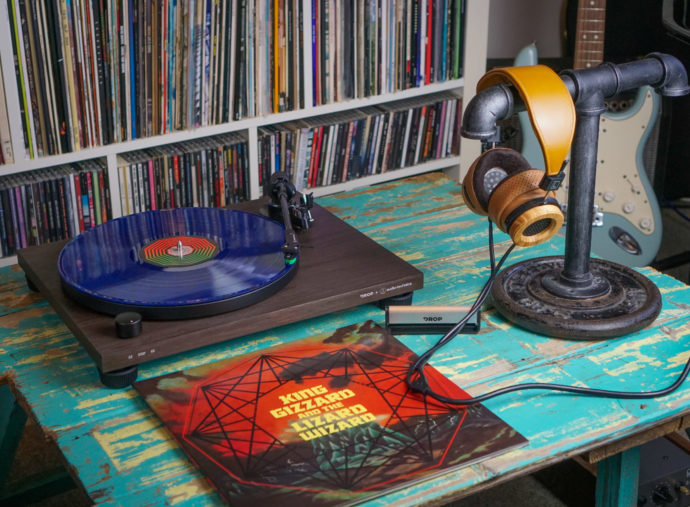
Drop + Audio Technica Carbon VTA Turntable, Grado GH1, and King Gizzard and the Lizard Wizard’s ‘Nonagon Infinity’.
Now that my little treatise on vinyl is over (thanks for the indulgence), hopefully you guys have a bit of context as to why it’s still the preferred format of millions of listeners the world around, and why people are actually deciding to take it up for the first time – in droves, actually. In fact, vinyl is on track to outstrip sales of CDs for the first time since 1986 (which is hardly surprising considering the venerable Compact Disc is a pretty unsexy kinda format).
And it’s not *just* a two-channel/stereo format proposition – vinyl playback over headphones can be a highly enjoyable and viable way to enjoy music for all the reasons I mentioned earlier, plus you get all the intrinsic benefits of headphones: it becomes even more intimate; it’s relatively far less expensive; plus there are no pesky room reflections and sonic gremlins to contend with when you have the transducers strapped to your ears.
Analogue inception
The fact that vinyl is making a resurgence certainly wasn’t missed by the team at Drop (formerly ‘Massdrop’), who had been itching to create something for existing and would-be vinyl fans, but hadn’t been able to prioritise in their product-planning pipeline to-date. I had a fun conversation about all things vinyl with Will Bright, Drop’s Chief Product Officer, and Thomas Fernandez, Drop’s Audiophile Product Lead last month, and one thing became quickly clear – when people who love vinyl start talking about vinyl with each other, the conversations go real deep, real fast. There’s a certain shared passion and understanding between fans about the nuances, quibbles and rewards of vinyl collecting and playback, and the Drop team saw this happening in their own community forums. Inspired by the level of passion they saw in their own community, they took a punt that there was enough critical mass in the community to launch their first turntable: the Carbon VTA.
Creating a turntable from scratch is no mean feat, especially when it’s designed to be a complete entry-level turntable – the benchmark that Drop was aiming for. But, it had to be much more than that. See, the other thing about the vinyl community is that we are insufferable perfectionists, and so any turntable would need to heed exacting audiophile standards. So, anything that the Drop team undertook would need to be good enough to potentially be “the only turntable you’ll ever need”. So with this in mind, Drop turned to a manufacturer with decades of experience in the vinyl domain – Japan’s Audio Technica, which is a name that Headfonia readers will certainly love, respect, or at least recognise when it comes to headphones (check out our previous Audio Technica reviews here). Will explained that Drop has been keen to collaborate with Audio Technica for the best part of a decade and so when they were looking for a partner to collaborate with for their first turntable, they were a no-brainer. Audio Technica is particularly famous for their know-how with phono cartridges and their current flagship cartridge, the AT1000, can be all yours for the paltry sum of $6,999 if you’re feeling spicy.
The Drop + Audio Technica Carbon VTA Turntable
It’s a bit of a mouthful, but this is the moniker of the resulting turntable from Drop and Audio Technica’s first-ever collaboration, and Drop’s first-ever turntable. Nominally based on the AT-LPW40WN, the Carbon VTA (the name we’ll go with from here) dips into the Audio Technica parts bin and boasts some premium features from more expensive models in the line-up exclusively for Drop customers.
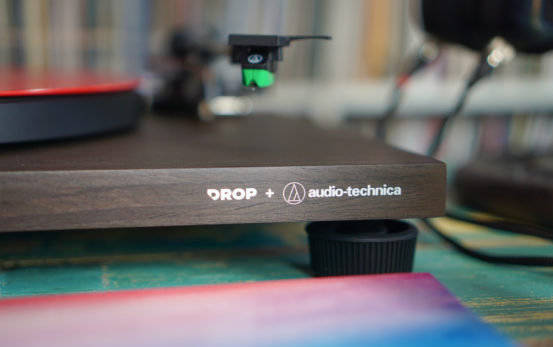
Drop + Audio Technica Carbon VTA Turntable.
To describe the Carbon VTA in a tweet: It’s a fully manual belt-driven turntable with selectable 33/45 speeds, a replaceable AT-VMN95E cartridge, and a built-in phono stage.
Headfonia readers should take careful note of that last feature: the built-in phono stage. The uninitiated among you might not realize that you can’t just take the RCA-leads out of any old turntable, plug them into any old amp and expect to make music happen. You see, the voltage that’s generated in the headshell of the cartridge is tiny. Whereas the standard ‘line-level’ voltage of a CD player or DAC is 2V, moving magnet (the more common type of cartridge, as opposed to moving coil) cartridges only output somewhere around the 5mV mark. So this means you need to pre-amplify the signal before it goes to an amplifier, with the help of a phono pre-amplifier circuit. Many old stereo amplifiers have a ‘PHONO’ input alongside their standard line-level inputs to take care of this conundrum, and it’s becoming increasingly common to see this in modern amplifiers as well.
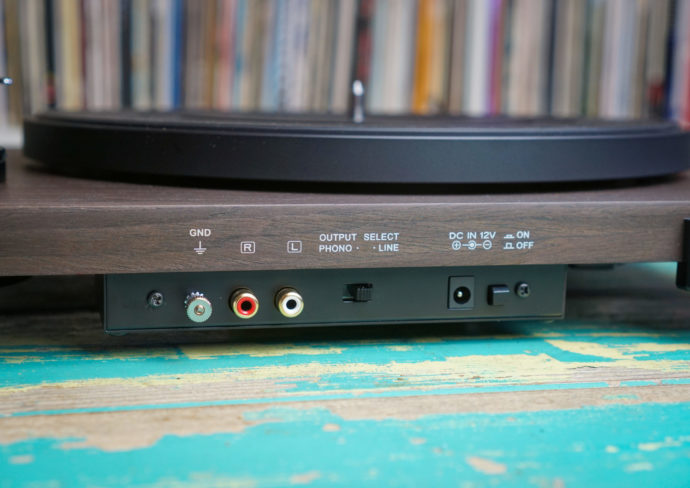
Selectable phono / line-level out.
There are some dedicated headphone amplifiers that include the option for an in-built phono stage, including the Schiit Lyr 3 (reviewed here by Linus), the Cambridge Audio Duo, and the Mytek Brooklyn Dac+ (also reviewed by Linus here). The Carbon VTA’s built-in phono stage alleviated the need for a dedicated amp with a phono stage, or a separate phono preamplifier requiring yet another box, set of RCA cables and wall-wart into your system. This means that you’re free to plug it directly into any headphone amplifier’s RCA-in, and off you go.
The turntable in my current hifi set-up – a 1980’s vintage Rega Planar 2 – doesn’t have a phono stage. This requires me to either use a Schiit Mani phono preamp, or to run it through my vintage NAD 3020 receiver, and use the ‘tape-out’ RCAs to feed a separate headphone amplifier. Slightly clumsy, I know.
Here’s the TL;DR version of the need-to-know specs for the Carbon VTA, as well as what you get in the box:
- Type: Belt-drive manual turntable
- Motor: DC servo with active speed stabilization
- Drive method: Belt-drive
- Speeds: 33-1/3 RPM, 45 RPM
- Turntable platter: Die-cast aluminium
- Wow and flutter: < 0.15%hi WRMS (33 RPM) at 3 kHz
- Signal-to-noise ratio: > 60dB
- Pre-amp “PHONO” output level: 4.0 mV nominal at 1 kHz, 5 cm/sec
- Pre-amp “LINE” output level: 200 mV nominal at 1 kHz, 5 cm/sec
- Phono preamp gain: 35 dB nominal, RIAA equalized
- Tonearm type: Static balanced, straight carbon tonearm
- Effective arm length: 8.8 in (223.6 mm)
- Overhang: 0.7 in (18.6 mm)
- Tracking error angle: < 2 degrees
- Applicable cartridge weight: 0.4 – 0.6 oz (12 – 17 g)
- Stylus pressure adjustment range: 0 – 0.1 oz. (0 – 3 g)
- AC adapter: Input 100-240V 50/60Hz Plug Type A. Output 12 V, 0.5 A
- Dimensions: 16.5 x 13.4 x 4.6 in (42 cm x 34 cm x 11.7 cm)
- Weight: 10.40 lb (4.7 kg) without dust cover
Included:
- Dust cover
- AT-HS4 headshell with premounted AT-VM95E stereo cartridge
- 45-RPM adapter
- RCA audio cable, 3.3 ft (1 m)
- AC adapter, 4.9 ft (1.5 m)
- Hex key
- Carbon fibre cleaning brush
Head over to Page Two to continue our review, just CLICK HERE.







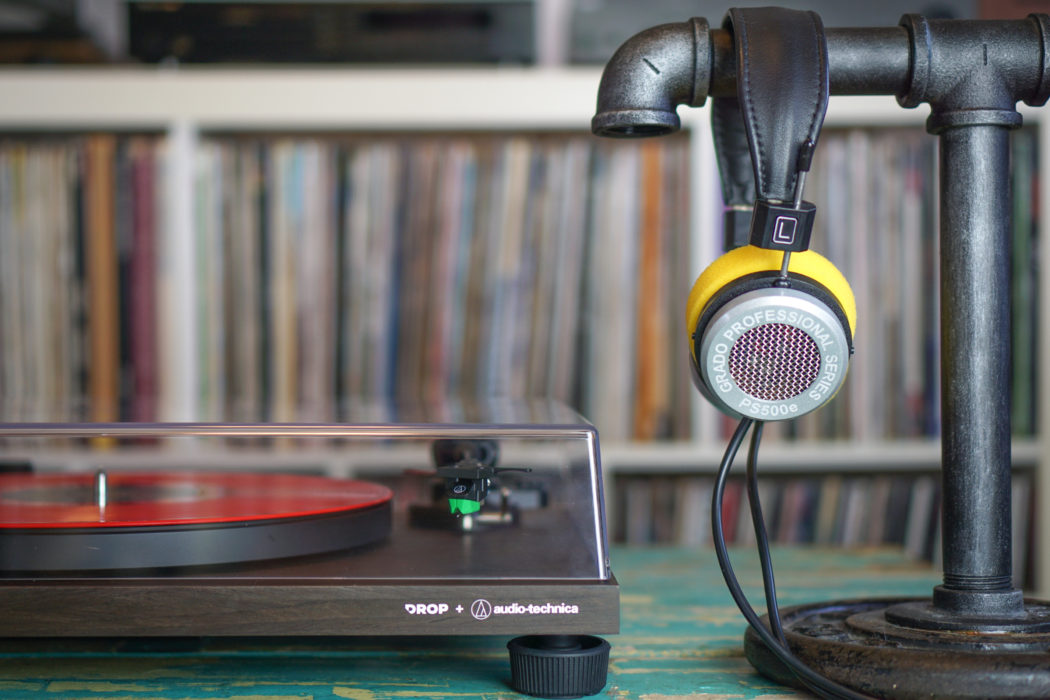
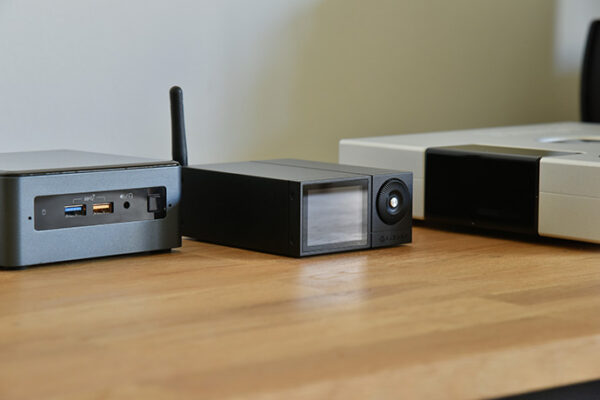

Sp12er
no direct comparison to the rega despite mentioned multiple times as being in the possession of the writer.
Well then again its mostly adticle as usual.
Matty Graham
Thanks for dropping-by Spi12er. If you’d like to send me 2 x copies of your favourite LP, 2 x identical cartridges plus an A/B switching box I’d be happy to do some direct comparisons.
*By that, I mean that it’s not really useful nor fair comparison being a 35-year old turntable that’s been modified with a bunch of aftermarket parts. Plus, I couldn’t really swap-out the TT’s in my system quickly enough to give you a meaningful comparison.
Sammy
Hello and thank you for your review. I am just digging into buying my first turntable and have been struggling with some of the technical aspects that go along with the purchase. Understanding the phono output types and if my current phono input (MM vs MC) on my receiver supports it is not as easy as one would think. I appreciated your information and review. I am a huge fan of Drop personally and usually just say “Shut up and take my money”, but there are a ton of options in the 3-500 price range I am trying to stay in and I don’t have the knowledge I usually do. You helped me get 3/4 of the way there. Cheers!